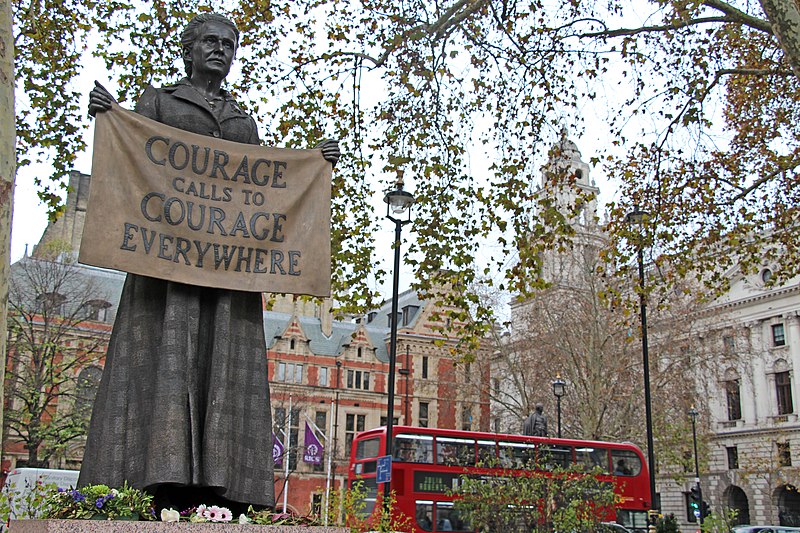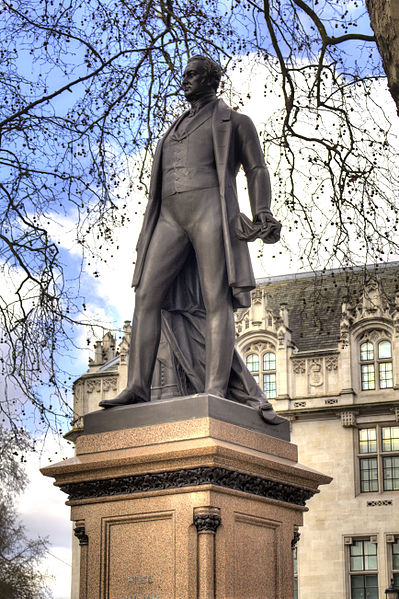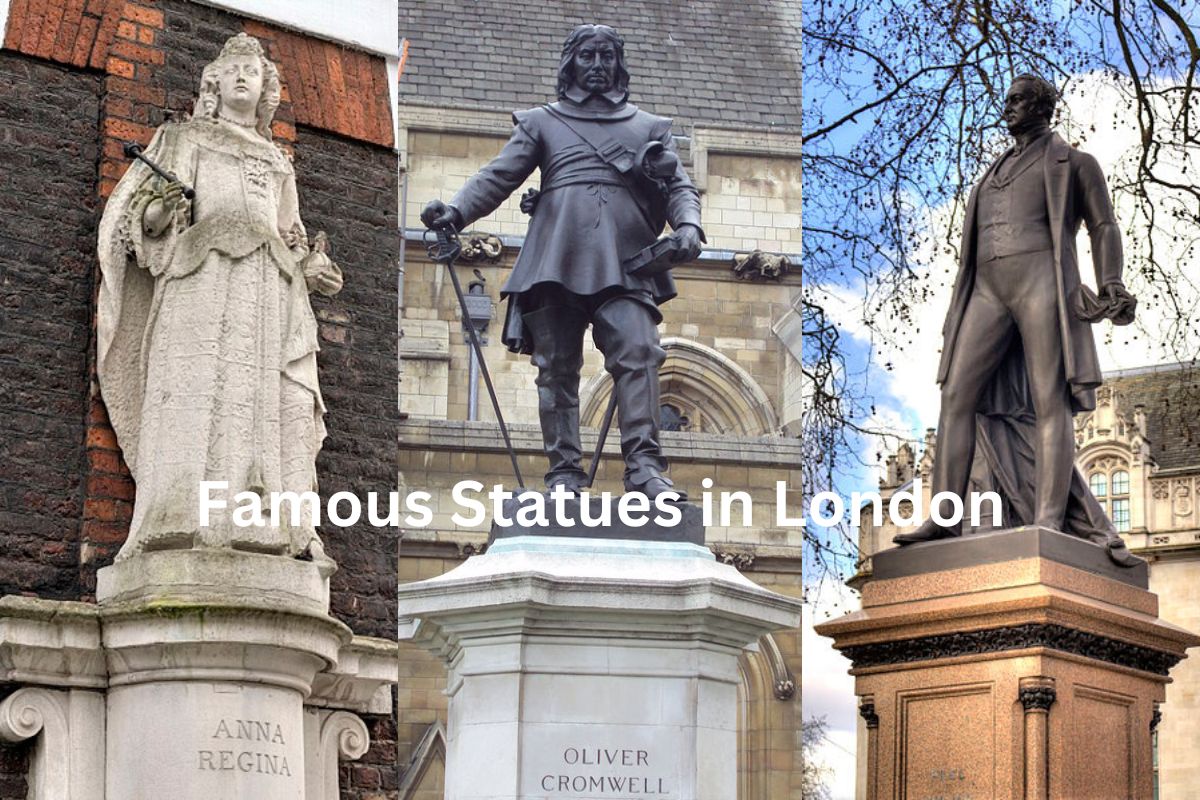London is teeming with history dating back before the middle ages and it’s one of the world’s most-visited cities.
In addition to the elaborate and iconic architecture inside London, the city is also known as one that has a very large number of statues that are found throughout its streets and parks.
In this article, we will examine some of the most famous statues in London, as well as the artists behind the works along with each statue’s purpose.
Famous Statues in London
1. Statue of Oliver Cromwell, Westminster – Hamo Thornycroft

Oliver Cromwell was a famous military figure and politician who is often regarded as one of the United Kingdom’s most prominent individuals.
He was appointed Lord Protector over the Commonwealth of England, Scotland and Ireland from 1653 to 1658 and his statue located in London is arguably the most well-known in the U.K.
The statue is located outside the House of Commons of the United Kingdom in Westminster, London.
The statue was erected in 1899 and is the work of Hamo Thornycroft, a notable sculptor who is known for creating some of London’s most famous statues, as well as many in other cities across the United Kingdom.
The Statue of Oliver Cromwell, Westminster was cast in bronze by John Webb Singer, another name among those in the British art world.
It was unveiled on October 31, 1899 during a speech by then Prime Minister Lord Rosenbery, who is recorded as one of the main donors for the project.
2. Sherlock Holmes Statue – John Doubleday

There is no greater mystery novel figure from the world’s great literary works than that of Sherlock Holmes.
He was the creation of Arthur Conan Doyle, a celebrated British writer and physician who wrote a series of books detailing thrilling mysteries that Holmes worked to solve alongside his well-known assistant, John Watson.
A statue of this fictional character stands in London at the site that is supposedly 221B Baker Street, which is the location of Holmes’ fictional address in the novels.
Known locally as the Sherlock Holmes Statue, this bronze work was completed by John Doubleday in 1999.
The statue stands at a height of approximately 9.8 feet and depicts Sherlock Holmes in the same way that illustrator Sydney Paget wrote of the figure throughout the late 19th century, with his signature cap and Inverness cape while holding a calabash pipe.
Visitors often stand next to this larger-than-life statue for photos and this is a popular destination for many of London’s top guided tours.
3. Statue of Robert Raikes, London – Thomas Brock

Robert Raikes was a prominent English figure during the late 18th and early 19th centuries who is best known for his work in philanthropy and as a Protestant minister.
He is often credited as the “father of Sunday school” as Raikes was a staunch proponent of an organized system in which the children of Christian church members could be educated in the faith and its religious practices and teachings.
He was able to publicize his ideas thanks to the fact that Raikes inherited a publishing business from his father in 1757.
Today, the Statue of Robert Raikes stands in the heart of London at the Victoria Embankment Gardens. The statue itself was completed in 1880 by Thomas Brock, who was a famous sculptor known for creating bronze artwork.
A special unveiling ceremony was held with the statue being officially presented to the public by the Earl of Shaftesbury in the same year it was completed.
Today it remains one of the most recognized statues in London and a central piece of the famous Victoria Embankment Gardens.
4. Yuri Gagarin Statue – Anatoly Novikov

The section of England’s capital city known as Greenwich is filled with a litany of statues commemorating various historical figures that have played a role in the formation of the country and its ideals.
One of the more recent works included among these is the Yuri Gagarin Statue that stands in front of the Royal Observatory in Greenwich.
The statue was created by Anatoly Novikov, a famous Russian sculptor who lived during the Soviet era and completed many works that celebrated his nation’s achievements.
The Yuri Gagarin Statue depicts the famous cosmonaut, Yuri Gagarin, who is known as the first person to venture into outer space–an accomplishment that set the Soviets ahead of the Americans in the race to explore space outside of Earth’s atmosphere.
The zinc statue stands at 11 feet in height with the base making up the majority of this measurement. Gagarin is portrayed in his signature cosmonaut outfit, raising his hand in the same pose he was photographed in when he first returned to Earth from his trip into outer space.
The statue curiously faces one of Gagarin’s contemporaries, Captain James Cook, who was one of Britain’s greatest explorers during the 18th century.
5. Millicent Fawcett Statue – Gillian Wearing

Millicent Fawcett was one of the leading figures of the women’s suffrage movement in England. This movement took place at roughly the same time as the American women’s suffrage movement and it would eventually lead to women being given the same rights as men under all legal systems in both countries.
Fawcett was the daughter of a wealthy businessman and worked tirelessly to advance the cause of women’s rights during a time when there was great opposition to such ideology.
Another one of London’s most famous statues is the Millicent Fawcett Statue, which is located in Parliament Square in the city’s downtown section.
It was created by Gillian Wearing, an exceptionally gifted sculptor who focused much of her work on sculptures related to the family and women’s issues in particular.
6. Statue of Robert Peel, Parliament Square – Matthew Noble

Many of the famous statues in London are often described as having an elegant appearance to them.
One in particular that fits this description is the Statue of Robert Peel, which is also located a short distance away from the Millicent Fawcett Statue in Parliament Square.
It is a strikingly beautiful bronze work that stands at nearly 12 feet in height and has remained one of the city’s most well-known statues since it was erected in 1876.
The Statue of Robert Peel was created by Matthew Noble, one of Britain’s most accomplished portrait sculptors throughout the 19th century. This statue was the last work that Noble completed in his long, illustrious career.
7. Statue of Clement Attlee – Frank Forster

The Mile End section campus of London is home to Queen Mary University of London and also boasts some of the city’s greatest statues.
One that deserves to be included on our list is the Statue of Clement Attlee, which was erected in 1988 after it was completed by Frank Forster.
It was commissioned by the Greater London Council and was originally intended to stand in Mile End Park, but by the time the bronze work was finished, the GLC had been dissolved.
After benefactors from the nearby university worked to fund the erection of the statue near the institution, the Statue of Clement Attlee at last found its home. Standing at a height of 6.8 feet, this is often pointed to as Forster’s greatest work.
8. Statue of Winston Churchill, Woodford – David McFall

There is little argument that Sir Winston Churchill is one of England’s most famous figures in recent history.
The political leader came to power during a volatile time when World War II was bearing down on Europe and Churchill’s decisions and leadership helped the nation pull through a dark period in which the powerful German military devastated much of the coastline and cities.
The Statue of Winston Churchill is easily one of the most famous throughout the city of London. It is a bronze work that is located in the Woodford section of London and stands at a height of 9 feet.
9. Statue of Queen Anne, Queen Anne’s Gate – Francis Bird

Queen Anne is recognized as one of the British monarchy’s greatest figures in the last 300 years.
She was Queen of England, Scotland and Ireland for a few short years in the early 18th century. The Statue of Queen Anne stands at Queen Anne’s Gate in the city of London since it was erected in 1705.
This magnificent work of art is carved our of Portland stone and depicts the queen wearing a brocaded skirt and bodice, as well as an open cloak which bears the insignia of the Order of the Garter. The sculptor responsible for this masterpiece is still unknown to this day.
10. Statue of Charles II, Royal Hospital Chelsea – Grinling Gibbons

There are few statues in London that are more iconic and eye-catching than the golden Statue of Charles II, which is located in the courtyard of the Royal Hospital Chelsea.
This brass statue is the work of Grinling Gibbons who completed it in 1680.
The statue was commissioned by Tobias Rustat, a member of the king’s court and it was moved to its current location after the death of Charles II.

